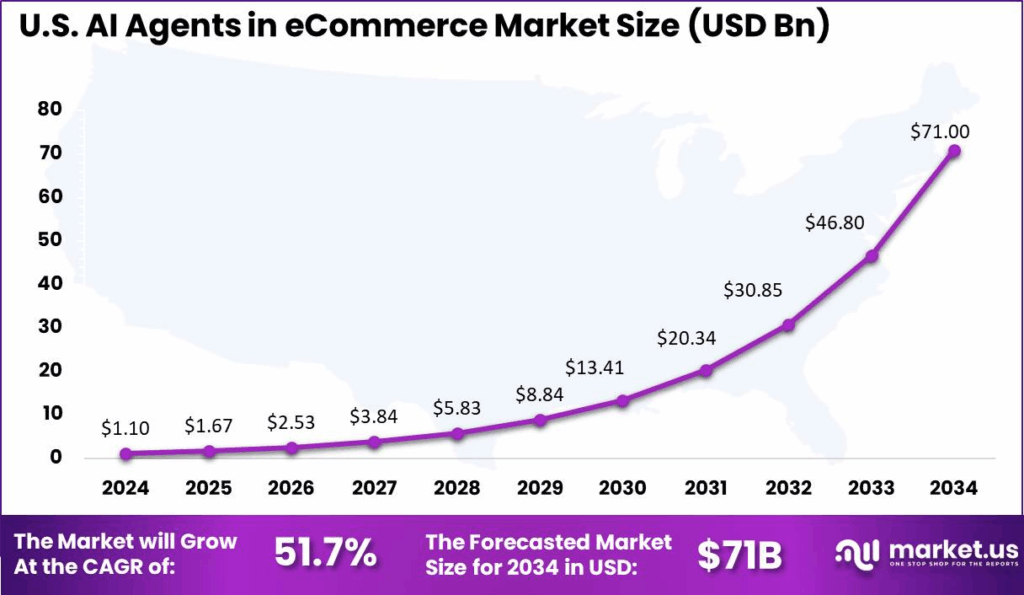How Retail AI Technology is Revolutionizing E-commerce Strategy

Retail AI technology empowers smarter, faster decisions across all facets of e-commerce, from demand forecasting and real-time fulfillment to personalized customer experiences and optimized customer service.
The best AI tools, such as an AI-powered OMS, can give you real-time visibility and configurable fulfillment logic to reduce costs and scale efficiently. These tools offer real-time integration, explainable logic, CX connectivity, and configurability for enterprise-level agility.
Embracing AI now will gain a long-term edge in resilience, speed, and customer loyalty across omnichannel operations.
AI is no longer a futuristic concept—it’s transforming every retail corner, especially in e-commerce. Traditional tools are insufficient, with consumers demanding faster deliveries, hyper-personalized experiences, and seamless omnichannel journeys.
Considering modern customers’ sky-high expectations and fierce competition, manual spreadsheets or guesswork are no longer sufficient. In fact, in 2023, 33% of B2C and B2B retailers had fully implemented AI in their e-commerce operations, while nearly half were still experimenting with it, indicating that AI is rapidly becoming a baseline requirement.

Source: CapitalOne Shopping
In this article, we’ll review how retail AI technology is reshaping e-commerce strategy, from more intelligent demand forecasting and personalized experiences to optimized fulfillment and operational agility.
What is retail AI technology?
Retail AI technology uses artificial intelligence—including machine learning (ML), computer vision, and natural language processing (NLP)—to optimize retail operations and enhance the customer experience. It acts as a strategic enabler rather than just a tool, transforming processes at every stage.
Key capabilities:
- ML for demand and behavior prediction: AI models forecast customer demand using historical sales data, seasonality, and external signals—helping you avoid stockouts or excess inventory.
- AI agents and virtual assistants: AI agents powered by NLP can handle routine customer requests, support staff, and even guide users through browsing. The AI agents market in the U.S. is projected to grow to $71 billion by 2034.

Source: Market Scoop
- Computer vision for inventory and shelf analytics: Deep learning enables real-time stock tracking on shelves using object detection and pose estimation, which is critical in cashier-less and smart-store environments. In 2024, North America led the global computer vision AI market in retail marketing, capturing a 37% share.
- Personalization engines for marketing and recommendations: Recommendation systems use behavioral data to instantly tailor product suggestions and offers, boosting conversion and customer loyalty.
- AI-driven order management and fulfillment optimization: AI intelligently routes orders to the best fulfillment location (warehouse, store, or third-party) to reduce shipping costs, speed up delivery, and minimize split shipments.
By combining these capabilities, retail AI becomes a growth engine rather than just a tech upgrade. It enables faster decision-making, smarter inventory allocation, elevated customer experiences, and operational agility, driving efficiency across channels.
Why AI is becoming essential in e-commerce strategy
Skyrocketing customer expectations
- Consumers define fast shipping as under 3.1 days on average, with 97% considering same-day delivery fast and 95% viewing next-day delivery as acceptable.
- These expectations are revolutionizing delivery strategy across the U.S., prompting retailers to upgrade logistics and fulfillment logic or fall behind.
Margin pressure
- Commoditized e-commerce and rising logistics costs are squeezing margins.
- Without smarter fulfillment strategies, you risk reduced profitability or unattainable pricing.
Inventory complexity across channels
- Selling across digital, physical stores, marketplaces, and social channels has created hybrid fulfillment challenges.
- Traditional tools struggle to handle inventory syncing, fulfillment rules, and channel variance at scale.
Data overload
- 51% of retailers report lacking access to real-time data. More than half of retailers (and 39% of grocery merchants) are not fully data ready, meaning they struggle with fragmented, outdated, or siloed data systems.
- Additionally, 47% of employees claim they receive data that are unrelated or irrelevant to their daily responsibilities.
Need for agility amid disruptions
- As a retailer, you must adapt to evolving trends and take measures to tackle demand spikes, supply chain shifts, or external events while maintaining consistent service levels.
- Static systems can’t flex or learn in real time.
Traditional technologies and manual workflows simply can’t close these gaps. However, AI can empower you with real-time visibility, predictive intelligence, dynamic order routing, and automated decision-making across inventory and fulfillment. This can mean an opportunity to attain higher efficiency, lower costs, and enhanced customer satisfaction.
5 ways AI is transforming e-commerce strategy
1. Smarter demand forecasting
- AI models intelligently forecast future demand by analyzing sales velocity, historical sales data, seasonality, and external signals such as promotions and weather.
- This precision reduces supply chain errors by 30–50% and cuts inventory costs by up to 25%, helping you avoid stockouts or overstocking.
- It results in more agile purchasing and merchandising decisions grounded in real-time insights.
2. Personalized customer experiences at scale
- AI personalization engines can dynamically tailor product recommendations, introduce new offers, craft marketing messages, and enhance site experiences.
- Around 73% of the U.S. marketers report using AI to power personalized experiences, meeting rising consumer demand for relevance.
- 71–76% of customers expect personalization across touchpoints, and brands that deliver see stronger customer loyalty and higher conversion rates.
3. Optimized inventory and fulfillment
- AI-powered OMS platforms dynamically route orders to the ideal fulfillment location, whether store, warehouse, or 3PL partner.
- This helps reduce split shipments, minimize shipping costs, and improve inventory turnover and margins.
- fabric’s AI-powered order orchestration platform can help you blend real-time inventory with configurable fulfillment rules.
4. Automated customer service and support
- NLP-driven AI agents can handle routine inquiries, resolve issues without human intervention, and free your support teams for complex tasks.
- Over 44% of U.S. companies expect to adopt AI chat representatives in the next two years, and 75% already reported improved CX through instant messaging tools.
- As a result, customers get faster support, and satisfaction scores rise.
5. Data-driven decision-making across the business
- AI aggregates raw data from marketing, operations, and logistics into digestible insights and predictive alerts.
- Retailers gain visibility into performance drivers—from merchandising and pricing to fulfillment and CX.
- This enables agile, test-and-learn strategies with lower risk and faster iteration cycles.
What to look for in AI-powered retail tools
If you’re evaluating next-gen AI tools, focus on these critical criteria to ensure long-term value and operational alignment:
1. Real-time data integration
- Look for a platform that ingests and synchronizes data instantly from your OMS, e-commerce platforms, and other key systems.
- Real-time integration ensures accurate decision-making across inventory, pricing, and fulfillment.
- fabric’s composable, API-first architecture allows seamless integration with your existing infrastructure via fast and scalable APIs.
2. Scalability across regions, SKUs, and fulfillment locations
- You need tools that can flex as you add more stores, product lines, suppliers, or geographies.
- The AI platform you choose should support expansions without requiring major overhauls, whether scaling to new regions or adding 3PL partners.
- fabric’s modular design allows incremental launches (e.g., real-time inventory, store fulfillment) while preserving operational continuity.
3. Transparent logic and decision explainability
- Choose tools with explainable AI (XAI) capabilities so your teams can review and understand the rationale behind decisions.
- This transparency builds trust across stakeholders and helps uncover biases or errors.
- Explainable AI improves trust and enables refinement of ongoing rules, forecasting, and fulfillment logic.
- fabric’s OMS delivers visibility into AI-driven decisions with configurable logic layers, giving you complete control over how orders are routed and fulfilled
4. Integration with customer experience platforms
- Ideal AI tools connect naturally with CRM, personalization engines, marketing automation, and search platforms.
- This ensures consistent customer profiles, tailored promotions, and personalized web experiences.
- fabric’s ecosystem-friendly architecture supports integration with various CX tools and partner services.
5. Configurability for unique business rules
- You must be able to configure fulfillment logic and AI rules based on location, cost, product type, or service level.
- Tools that allow custom rule-setting and incorporate AI recommendations empower operational flexibility, such as BOPIS gating logic or prioritized routing.
- You can manage fulfillment rules with fabric through a simple UI, enabling fast adjustments without engineering cycles.
The future of AI in e-commerce
- AI as a strategic backbone: AI will evolve beyond optimization to become the decision-making core of modern retail strategy, powering category planning, promotional strategy, CX pathways, and supply chain orchestration.
- Agility, resilience, and loyalty: Embracing AI today can help you unlock greater flexibility during demand swings, faster reactions to disruptions, and stronger customer loyalty through consistent and personalized experiences.
- Improved prediction, autonomy, and precision: As machine learning modules mature and latency shrinks, AI will increasingly anticipate demand, trigger autonomous fulfillment decisions, and continuously refine strategy, delivering unmatched precision.
AI isn’t just an upgrade—it’s a retail revolution
AI is now emerging as the core driver of e-commerce. From demand forecasting and customer engagement to unified inventory management and fulfillment, AI is fundamentally reshaping how retail businesses operate, compete, and grow.
Embracing AI early can allow you to move faster, decide smarter, and achieve better profitability. It doesn’t just respond to trends; it predicts and acts on real-time information, creating experiences that your customers will remember and return to.
Ready to explore how AI can transform your e-commerce strategy? Get in touch with us and discover how our intelligent OMS can help you confidently automate, predict, and scale.

Digital content editorial team @ fabric





